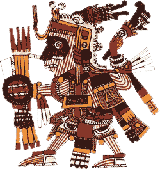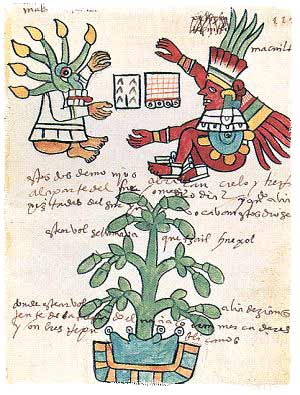|
The history of chocolate - the facts, the myth and the legend.
The true history of chocolate is one of those histories where fact is stranger than fiction, and takes on the quality of myths and legends. The origins of chocolate can be traced back at least three thousand years. The first peoples to enjoy the rich sensuousness of chocolate are thought to be the mysterious ancient civilisations of the Olmec and the Maya. These civilisations who lived in the heart of equatorial Central America are responsible for cultivating the trees from which all the chocolate in the world is derived. What we do know starts with the Olmec people who lived in the area of tropical forests south of Veracruz on the Gulf of Mexico. This locality provided the unique growing conditions needed by the cacao tree. The tree can only grow in tropical areas within 20 degrees of the equator. It cannot grow if it is too high, too cold, or too dry, and it needs shelter from wind and sun. It requires protection from all manner of wild animals and is very susceptible to various diseases and ills if not grown in near perfect conditions. With the demise of the Olmec, the cacao tree continued to be cultivated by the Maya, who lived in an area from the Yucatan peninsula in Central America to the Chipas, and across to the Pacific coast of Guatemala. The Maya believed that the cacao tree was a gift to man from the gods. And in their written texts they refer to cacao as god's food. They carved sacred images of the cacao pods onto their palaces and temples. Exclusively for kings and the male elite, the cacao pod was their symbol for life and fertility, and was used only for sacred occasions and rituals. The seeds from the pods were dried and roasted and made into a frothy drink. It was a bitter brew, often combined with maize, and flavoured with chilli. The drink was mixed and frothed by pouring from a height from one vessel into another.
Learn more about how cacao beans are processed to make the drinks, confectionary and baking ingredients we love today. It was so revered and culturally important that it was also used as currency. A slave could be bought for one hundred cacao beans, a rabbit for four! It was named the cacahuaquchtl, while no other tree was considered to be worth naming!
Click on the picture if you are interested in finding out more about Mexican ancient history? This site has a map of the places that the different ancient clutures lived and links to other interesting sites. The Mayas, the Toltecs, Aztecs and mysterious Olmecs, the rich and mysterious history of this magical land.
Following the fall of the Mayas, the history of chocolate continued with the Toltecs. The myth is that Quetzalcoatl, the Toltec King, believed himself to be the god of the air. His earthly mission was to bring from Eden to man the seeds of the cacao tree and thereby teach mankind how to cultivate crops. Unfortunately, Quetzalcoatl was unpopular, having many social uprisings against him. He decided to flee his court and head south of the Yucatan, and, legend goes, while he was ill there, he was persuaded to drink a mysterious potion to cure his ill health. Instead, he became even more crazy, took to a raft, and set out to sea, promising that he would return in a preordained year to reclaim his kingdom. This became Aztec mythology, and astrologers predicted that in 1519 a white-faced king would return to claim his people. Now this could have been it for the myth of Quetzacoatl. It could have remained just that - a myth. And the history of chocolate could have remained unchanged over hundreds of years. Instead, it became mixed up with reality to devastating result, when in 1519, in the reign of Montezuma II, a white-faced European named Hernan Cortes landed on the continent. Montezuma thought that the prediction was being fulfilled, and treated the Spanish adventurer as a reincarnation of the returning Toltec King. He gave Cortes gifts of cacao pods and even a whole plantation. But Cortes was only an adventurer and soon the game was up. Montezuma was taken prisoner in his own court, and within three years the whole civilisation lay in tatters; Aztec society had fallen. Through the shared history of chocolate and man, chocolate had only been used in the small area where it grew, and only as a bitter frothy drink. Chocolate, the food from the gods, had only been drunk by earthly gods, the ruling kings and their priests. Through out the history of chocolate it has played an important role as an aphrodisiac and health tonic, made by the elite medicine men of the court. It was used as currency, and a source of wisdom and energy highly prized at royal weddings. It was at the very centre of rituals and economic existence, regarded as the only substance with vitality and life, providing sacred and healing properties to those who owned it and drank it. This phase of the history of chocolate ended with the demise of Emperor Montezuma II and the Aztec civilisation itself.
Interested in finding out more about Mexican cooking - with lots of lovely recipes? Rockin Robin's Mexican Food Recipes
The Traditional Mexican Cooking School
Check out how the Mexican history of chocolate preparation has influenced todays hot chocolate drinks.
|





